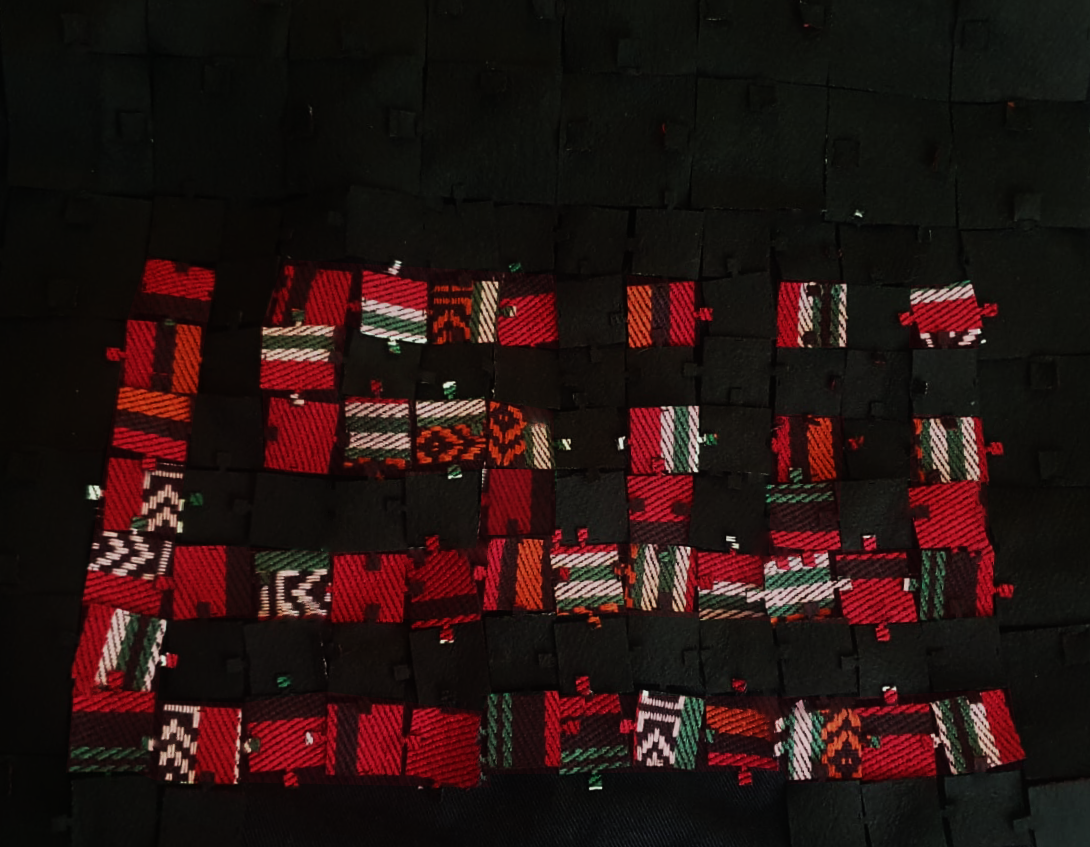03. Circular Open Source Fashion¶
References & Inspiration¶
Fioen van Balgooi and Berber Soepboer's dress design is a captivating fusion of creativity and innovation. The foundation of the garment lies in the ingenious use of squares, each with tabs and slots, rotated by 90 degrees to create a visually dynamic piece. This design not only showcases the inventiveness of the designers but also provides a rich field for exploration in fashion design, geometry, and material engineering, encouraging the study of modular construction, pattern transformation, and the role of geometry in wearable art.
Furthermore, this dress, beautifully captured by Savale.nl with model Marjolein Heij, invites contemplation on the intersections of art and fashion. It serves as a testament to the limitless possibilities of fashion, challenging conventions and demonstrating how innovative ideas can lead to groundbreaking creations, emphasizing the dual nature of fashion as both an art form and a functional means of self-expression.
1. Concept¶
A unique jacket design composed entirely of individual square panels, each with special interlocking joints that allow them to be assembled together without the need for stitching or gluing. These square panels would be made from a flexible yet durable material, like a high-quality fabric or a lightweight polymer. The squares would be precisely cut to have interlocking edges, similar to puzzle pieces, creating a seamless and stylish appearance. When you put on the jacket, you'd simply connect the squares at their designated joints, creating a sturdy and fashionable outerwear piece without the use of traditional sewing techniques. This innovative jacket design would not only showcase a modern and minimalist aesthetic but also offer the advantage of easy assembly and disassembly. You could mix and match different square panels to create custom patterns or change the look of the jacket whenever you desire, making it a versatile and eco-friendly fashion choice.

Tools¶
Steps & Workflow¶
1st attempt using Felt and Scissors¶
The idea of using felt squares with seamless joints and incorporating Arabian calligraphy as a changeable canvas is quite innovative and has the potential to create a unique and customizable piece of clothing. Consider using Arabic calligraphy to add intricate and beautiful designs to the squares.
I reversed the fabric on the colored side (white), specifically on the highlighted areas of the grid, to emphasize the calligraphy. Meanwhile, the unreversed fabric remains as a background (black), adding depth and creating a distinct visual contrast.
-
Designing the Arabic Calligraphy
-
Dividing the Design into a Grid: Divide the Arabic calligraphy design into a grid layout to fit onto individual felt squares
-
Creating Female and Male Connections:
Prepare the Felt Squares:
Cut the felt squares to the desired size for the project.
Use black felt for the fixed background squares. this square will serve as the female connection points.
Use white felt for the strips that will contain the male snap fasteners. These strips will serve as the male connection points.
Create Splits or Gaps in the Fixed Background (Black) Squares:
Strategically cut splits or gaps in the black felt squares to accommodate the white male strips. These splits should follow the grid layout to ensure proper alignment of the final design.
The splits should be positioned to match the placement of the male snap fasteners on the white strips.

Designing the 2D pattern¶
Designing the 2D pattern in Rhino involves further refining the female and male intersection, followed by selecting the appropriate fabric material for laser cutting processing.

The red line shows the cutting which the connection goes through and the green dashed line shows the underneath pieces that is the connection between a square and another.

2nd attempt using Velvet & Laser Cut¶
In the testing phase, the fundamental concept involves utilizing a simple interlock design. This design was systematically tested with velvet, which proved to be less than optimal and decision was made to use felt, a stiffer fabric, to enhance the overall strength of the design using Trotec Speedy400 to cut the fabric.
Through experimentation, it became evident that the integration of thicker fabric plays a pivotal role in achieving a resilient interlocking mechanism. This emphasis on a denser textile ensures durability and stability in the interlocking joints, ultimately fortifying the overall strength of the jacket. The squares, intricately cut with tabs and slots, seamlessly come together, presenting a visually appealing outerwear piece.

Material: The choice of material significantly impacts the overall look, feel, and functionality of the interlocking squares.
Thickness: The thickness of the material is essential for ensuring the stability and strength of the interlocking mechanism.

3d final attempt using felt-like fabric & Laser Cut¶
Laser cutting the interlocking shapes designed using the laser cutting machine Trotec Speedy400.
Power Setting: 70%
Speed Setting: 5 mm/s
HZ: 1000

Evaluating¶
Testing the design to ensure that the squares and joints work as intended and that the jacket is comfortable to wear. This concept has the potential to create a distinctive and versatile fashion item that appeals to a wide range of people interested in both fashion and art.

Assembling the Cartography شكرا¶
A one singular modular piece served as the foundation for crafting the entire garment.

Constructing the pieces together.
Assembly and Disassembly: Considering an easy interlocking squares assembled and disassembled aiming for modularity or interchangeability, ensuring a user-friendly process for connecting and disconnecting the squares.

Assembling the jacket¶



3. Fabrication files¶
-
File: Laser cut sheets ↩
